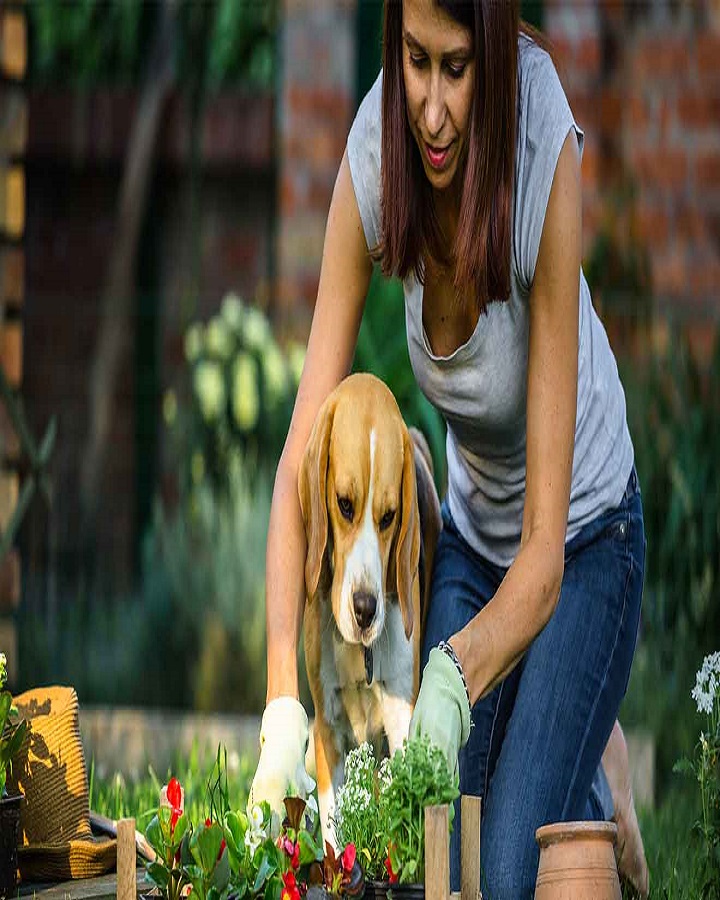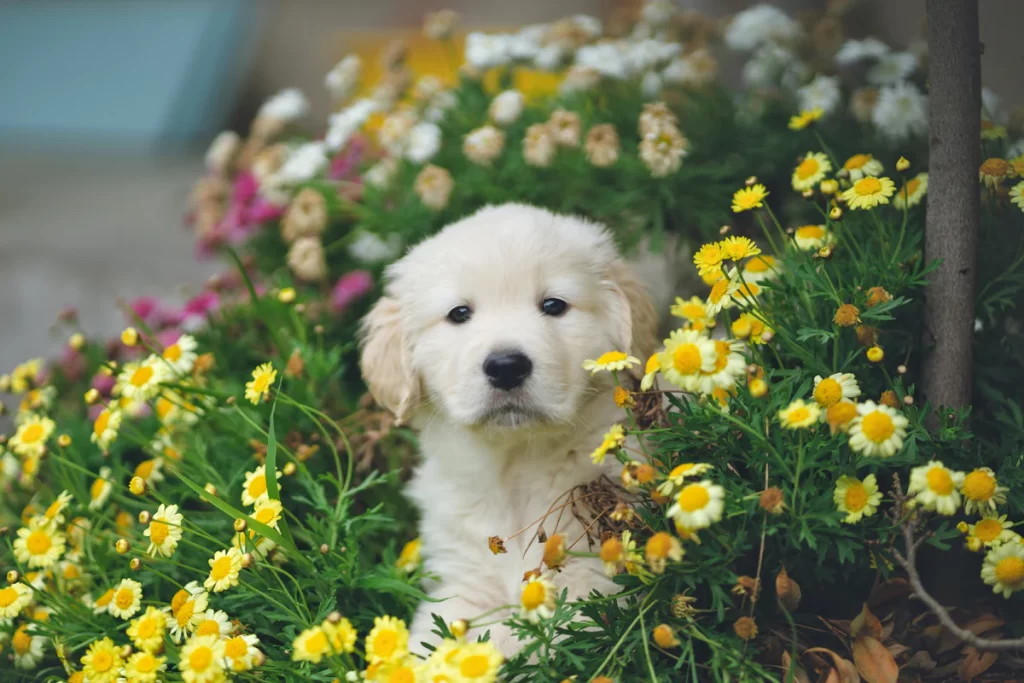
Image Credit – Hemapriya
Gardening is more than just planting flowers or growing vegetables—it’s about creating a peaceful, nurturing space that brings joy and relaxation. For many pet owners, this experience becomes even more meaningful with canine assistance. Dogs are not only loyal companions but can also play a supportive role in the garden, whether by keeping pests away, encouraging outdoor activity, or simply providing comfort and companionship while you work. With the right training and care, gardening with canine assistance turns into a rewarding activity that benefits both you and your furry friend.
Spring is sprung, the grass is riz;
I wonder where Rover is . . .
Wait. Isn’t that Rover in the garden? Digging in the soft ground? Digging up the onion sets? Get out of there, you rascal!!
Gardening with canine assistance

Many pet owners find it extremely difficult to maintain a garden and a good relationship with the family dog. The things that make a garden most successful are the very things that attract Rover’s attention: soft earth, wonderful for digging; organic fertilizer, wonderful for rolling in; and compost heaps, full of lovely, disgusting, rotting treats.
Rover’s also likely to chase the wild critters out of the garden — or through it — at breakneck speed. Rabbits, squirrels, turtles, birds, and snakes draw a dog’s attention, and dogs with high prey drive will not, cannot, give these creatures free reign in the yard. Chases aren’t over at sundown, either; when the opossums and raccoons take over the night world, the dog considers it his job to keep these guys out as well.
After the chase in early summer, the pooch finds the sunniest spot in the yard — usually the middle of the wildflower or annual garden or the emerging pumpkin patch — excavates a shallow cavity, and lies down, crushing the cosmos, marigolds, sweet peas or pumpkin seedlings beyond recognition. Later in the season, when shade is to be treasured, the impatiens and begonias beds are Rover’s prime choices for an afternoon siesta.
So, a little strategy is definitely in order.
First, a fence. You can keep most dogs out of the vegetable garden with a simple wire mesh fence strung on steel posts. A three-foot fence should work for all but the most determined pets; a four-footer might be necessary for some. To prevent Fido from digging his way into the garden to roll in some particularly disgusting new addition to the compost heap, bury the mesh up to a foot underground. You can also use electronic fence to keep Rover out of flower beds.
Obedience training for the garden
No, you don’t train the garden, you train the dog to behave himself in the garden! If you’d like to have Fido by your side as you work, teach him to lie down and stay in a special spot. Just as he learns to go to his crate or his bed in the house, so he can learn quickly to lie down in his own place in the garden. If you have a large garden, you can move the dog from one place to another; just make sure you control when he moves and where he moves to.
You can also teach Hunter to help with the garden chores. One friend with Labrador Retrievers puts a few garden tools in a child’s sand pail and gives the pail to a dog to carry. Teach Hunter the difference between a trowel and a weeding claw, and he can fetch the tool you left over by the tomato plants or dropped by the gate.
Teach your pet to come when he’s called and you can call him to you before he flattens the green beans or digs up the carrots. Better still, give him a space of his own to dig in so that he can “help” without doing any damage.
If you are a dedicated gardener and dog trainer, you can teach Rambo to pull a cart loaded with tools, grass clippings, even flats of plants or new trees or shrubs. You can modify a child’s wagon or build or buy a cart for the dog.
Toxic plants
The down side of allowing Fido in the garden is the potential for plant poisoning. Plants in the garden-favorite Solanaceae family (tomatoes, green peppers, potatoes, and eggplant) contain various amounts of neurotoxic alkaloids such as scopalomine and atropine . Although pets (and children) generally will not eat the leaves of the garden vegetables, potatoes left in the sun can synthesize solanin, which can be toxic in concentrated amounts and has been known to cause death in domestic animals.
Daturas and nightshades (belladonna), tomato cousins, contain more concentrated amounts of poisons. Both are annual plants spread by birds that eat the fruits with no ill effects. Nightshade is a vine with purplish stems and lovely purple flowers common in waste areas; the berries begin green, turn red, and, when ripe, are black; they were used to make a poison in Medieval Europe. Datura grows to six feet tall and has irregularly-shaped leaves and white, trumpet-shaped flowers. The fruit is known as thorn apples for its prickly covering.
Horse-nettle is another Solanaceae plant that can cause problems. It is deep-rooted, so is difficult to eradicate, and has fine, closely-spaced, needle-like thorns on stems and leaves. The flowers are purplish or white and potato-like. Brushing through horse-nettle is extremely irritating to bare skin; the thorns can break off and stab through clothing or pet fur.
These troublesome weeds can get into home gardens in manure that is not completely composted, so be aware of the possibility when using the real thing from stables or farms. Birds can also donate seeds of some poisonous or pesky plants.
The flower bed can be a source of poison for Pepper. Daffodils, foxglove, delphiniums, bittersweet, wisteria, lupine, buttercup, Mayapple, Dutchman’s breeches, morning glory, and periwinkle can cause a variety of ill effects from vomiting and diarrhea to hallucinations. Daffodils are not likely to cause a problem, for most dogs will not eat flowers, leaves, or seed pods. (Puppies have to be more closely watched, however.) Daffodil bulbs are playthings that may end up as snacks, particularly if they are fertilized with bone meal.
Fertilizers and pesticides
As time goes on, more and more home gardeners become wary of so-called chemical pest control agents and fertilizers. However, all of these agents — “natural” or synthetic — are chemicals; some, usually the man-made ones, are more toxic than others.
If you have children and pets and wish to avoid chemical weed control, you can destroy weeds by cultivating between plants and rows, pulling them by hand, or snipping them off at the soil surface, and you can limit infestations with heavy mulches. Layers of newspapers that rot and add to the soil for next year’s crops or purchased black plastic are both effective at keeping weeds out of the vegetable patch and flower beds. You can also take advantage of a number of recent developments in pest control that use natural pheromones and chemicals of low toxicity and little residual action to control insects. Insecticides with pyrethrins fall into the low-residue group.
Some gardeners use companion plantings to minimize insect problems and eliminate or reduce the need for pesticides. Plants in the tobacco family contain a natural insecticide, some marigolds protect against nematodes, tansy is a flea repellent, and nasturtiums repel a variety of bugs. Rodale Press has several publications that deal with organic gardening and books on the subject are available at area bookstores.
Fertilizers can be a problem to pets, particularly when applied to lawns that pets walk on. Nitrogen, so essential for green, leafy growth, can burn the pads on Ranger’s feet. Dogs are strongly attracted to gardens fertilized with bone meal, blood meal, or fish emulsion; if you use these natural fertilizers, be sure you can keep the garden safe from a determined digger.
For best results and least effect on pets and children, apply pesticides and fertilizers when the wind is calm and there is no rain in the forecast for a day or two. Keep pets and children inside when applying chemicals to avoid skin contact with and inhalation of the substance. Don’t let kids and pets on treated lawns for 24 hours, and don’t allow pets to munch on or roll in treated grass or weeds.
Gardening with canine assistance is a wonderful way to blend the joy of nature with the love of pets. Your dog can become your companion, helper, and even protector in the garden, making the time you spend outdoors more fulfilling. From keeping you active to offering unconditional support, dogs enhance the gardening journey in countless ways. So, why not bring your furry friend along the next time you head outside with your tools? With patience, safety, and love, gardening with canine assistance can become a cherished routine for both of you. Let us know in the comments how your canine assistance makes your gardening time more enjoyable—we’d love to hear your stories!
Frequently Asked Questions
How does canine assistance make gardening easier?
Canine assistance can help by keeping pests and small animals away, providing companionship, and encouraging regular outdoor activity, which makes gardening more enjoyable.
Can gardening with canine assistance benefit dogs too?
Yes! Gardening with canine assistance allows dogs to get exercise, mental stimulation, and fresh air while bonding with their owners in a safe, outdoor environment.
What precautions should I take when gardening with canine assistance?
Ensure your garden is dog-friendly by avoiding toxic plants, using safe tools, and designating spaces where your dog can roam freely without harming plants.






